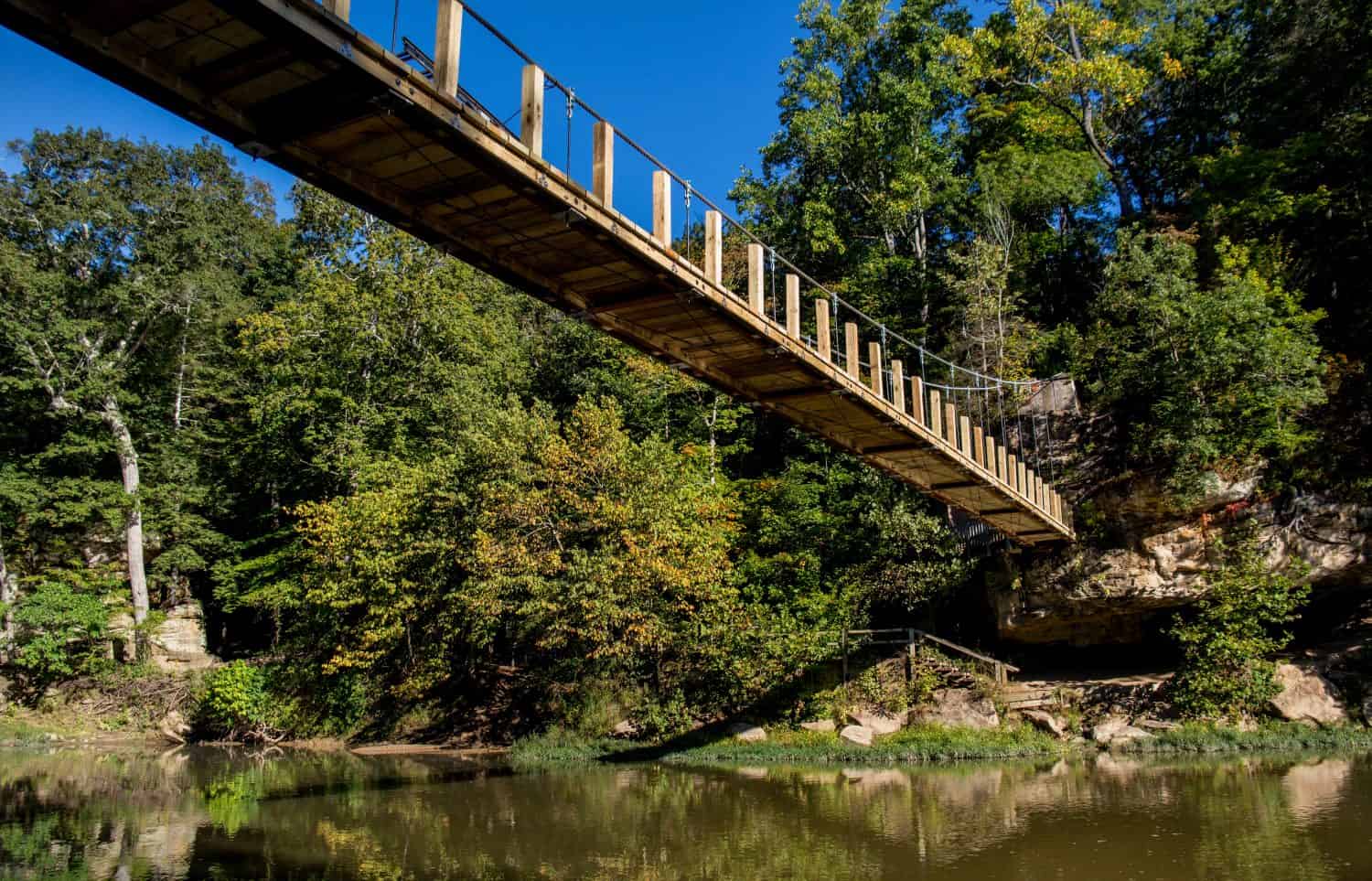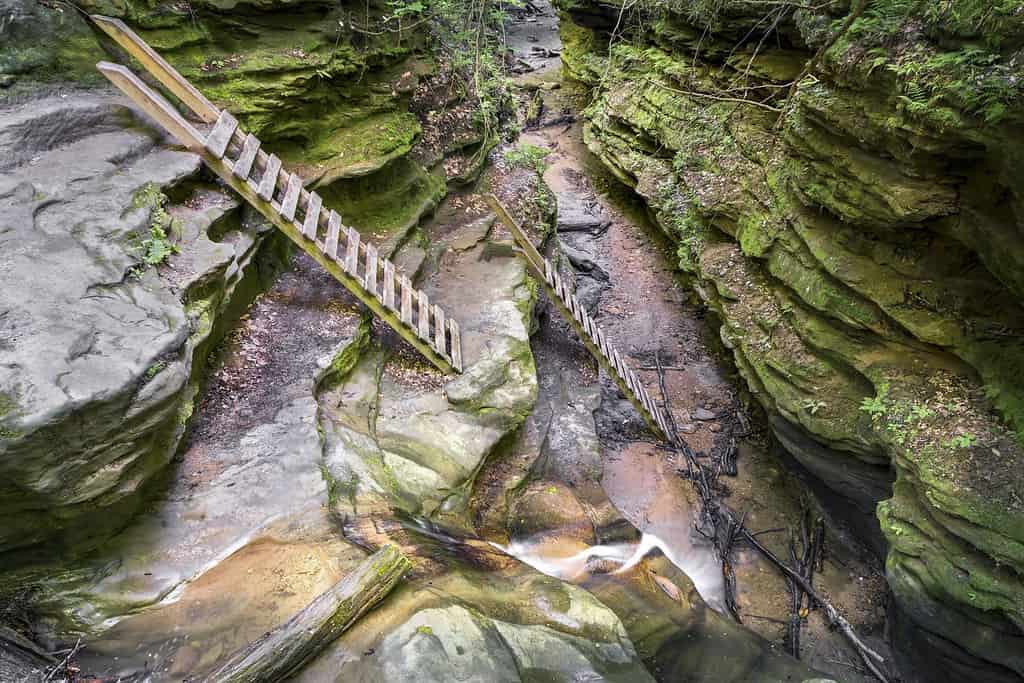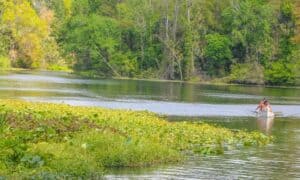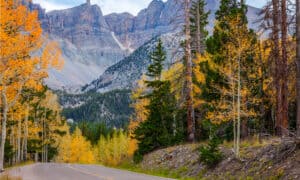Turkey Run State Park is one of Indiana’s top-rated state parks. In fact, it’s Indiana’s second official state park. With 2,382 acres, there’s something for every nature lover and history buff who comes to visit. Keep reading to determine the ideal visiting time and the best trails before planning your trip to the acclaimed Turkey Run State Park.
Turkey Run State Park

The sandstone cliffs in Turkey Run State Park are an ecological wonder.
©Jerald LaOrange/Shutterstock.com
The geology of Turkey Run State Park challenges the myth that Indiana is only flat farmland. The unique rock formations throughout the park are evidence of the region’s evolution, giving visitors a glimpse into what it looked like millions of years ago while the glaciers were melting.
Hikers can enjoy other remnants of the past when they walk through the canyons. Coal deposits were easy to find in the exposed bedrock of the Mansfield sandstone. As a result, the natural wonder was a popular mining site in the late 1800s to early 1900s before becoming a famous state park. Many structures and artifacts in the park are also leftover from Indigenous peoples and early American pioneers who lived in the area.
Turkey Creek State Park is open from 7 AM to 11 PM daily. Hiking trails are open from dawn to dusk. In winter, some activities may be temporarily limited or closed.
The Best Time to Visit Turkey Run State Park

See the colorful fall foliage along Sugar Creek when you visit Turkey Run State Park in the fall.
©Jerald LaOrange/Shutterstock.com
The best time to visit Turkey Run State Park depends on your preferences. The weather, scenery, and the amount of people in the park that day influence your experience at the acclaimed state park. But knowing what each season brings can help you decide the ideal time to visit.
Summers in Indiana are long, warm, and humid. Temperatures linger around 80 degrees Fahrenheit, and there’s a chance of rain on almost any given day. Despite the risk of a storm or a sunburn, it’s the park’s busiest time of year. Kids are out of school, and adults take time off work to spend some much-needed time outdoors. Summer is the best time for you to visit if you love the sun and don’t mind crowds.
Spring and fall are milder in comparison. However, temperatures in both seasons vary significantly depending on the time of the season. Rain is also an almost daily possibility. Be prepared for high waters that can close sections of the trails for days.
On the other hand, winter is very cold but only occasionally snowy or icy in the park despite other parts of the state receiving a lot of snow. The deep canyons help shield the park from some of the inclement weather. However, trails are sometimes shut down because of the snow. Due to the cold temperatures, the park isn’t too busy in winter. So, if you enjoy bundling up and traveling without company, winter may be the best time for you to visit.
What to Do at Turkey Run State Park

You have to cross Sugar Creek using the suspension bridge to travel many of the park’s hiking trails.
©Susan B Sheldon/Shutterstock.com
Hiking
There are over 14 miles of hiking trails at Turkey Run State Park. The popular activity takes hikers along rugged paths through the hemlock groves and deep canyons.
Most of the trails start by crossing the suspension bridge above Sugar Creek. Hikers get a good workout before the hike even begins by climbing 70 steps to get to the bridge. Once hikers cross the bridge, the trails take them through Rocky Hollow Falls Canyon, a nature preserve located deep in the sandstone canyon.
The hiking trails are distinguished by numbers 1-11 and vary in difficulty and length. It’s important to note that many trails except Trail 11 cross over the ravine, making them slippery and uneven.
Seasoned hikers will enjoy the 5 Mile Challenge that takes hikers from the Nature Center to the perimeter trails. The 5 Mile Challenge is a scenic loop that takes hikers up or down 1,500 steps and a ladder (depending on the direction you start from). It’s recommended you complete the challenge clockwise so you go down the stairs rather than up. The challenge includes Trails 3, 4, 5, 9, and 10.
Camping
Turkey Run State Park provides a variety of electric campsites for RV and tent camping. They also have a Youth Tent Camp and a helpful Camp Store. The campsites come with electrical hookups, picnic tables, fire rings, water supply areas, and restrooms for your convenience. There are also nearby campgrounds if spots are unavailable, but you still want to hunker down for the night at the park.
Canoeing and Kayaking
Sugar Creek runs through the middle of Turkey Creek State Park and is one of the most popular canoeing spots in the state. It’s important to note that the park doesn’t offer canoe services but there are several locations along Sugar Creek that do.
Sugar Creek can be dangerous, so swimming in the water is prohibited. If you want to go swimming, an Olympic-sized outdoor swimming pool is on campus.
Fishing
In addition to canoeing, visitors love fishing in Sugar Creek. Anglers will find bass, bluegill, and more in the scenic river. Keep in mind you will need a state fishing license to fish in the river. You can also go boat fishing at either of the two public access points outside the park.
Historic Sites
You can visit several historic sites at Turkey Run State Park. All of the structures are from the 1800s, giving visitors a glimpse into the lives of Indiana pioneers.
One such building is the Lieber Cabin. The Lieber Cabin was installed in Turkey Run State Park in 1918 and was created using tulip trees that early Americans commonly used to build their houses. It’s the oldest building in the park.
The Log Church was also removed from its original location and installed at the park. The non-denominational church has been at the park since 1923 and still holds services every Sunday from Good Friday to the end of October.
Another site reminiscent of the early pioneers is the Lusk home. Captain Lusk built his home and a gristmill in the mid-1800s. The home was restored and is open for seasonal tours.
Nature Center
Visit the Turkey Run State Park Nature Center to learn more about local wildlife. Look at the displays and interactive exhibits inside, or stay for a show at the theater. There are also rooms where you can watch some of the park’s wildlife through one-way glass.
The Best Trails at Turkey Run State Park

You have to climb the ladders in Bear’s Hollow to complete some of Turkey Run’s hiking trails.
©Kenneth Keifer/Shutterstock.com
Trail 3
Trail 3 is a rugged and strenuous 1.7-mile trek taking hikers along the cliffs of Sugar Creek. One of the most unique features along the route is the Ice Box, an incredible glacial formation. Once hikers pass the Ice Box, the trail leads them through the walls of Bear Hollow. Unlike most hiking trails, Trail 3 has wooden ladders. Hikers must carefully climb them to return to the ridge top from Bear Hollow.
Trail 3 to 5 to 9 Loop
The strenuous loop is about 4.7 miles and takes hikers through the park’s most scenic areas. Once you reach the ladders and reach Trail 5, you’ll reach the “140 steps” section. The surrounding greenery mimics the scenes from a fairytale. From here, hikers make their way to Trail 9 to cross the rocky grotto of Boulder Canyon. Loop back to Falls Canyon before ending the trail at the Ice Box overhang by the bridge.
Trail 3 to 10 to 9 to 5 Loop
The 5.5-mile moderately challenging loop takes hikers along Sugar Creek in the Ice Box and the Camel’s Back overlook. Trail 10 takes hikers along unique rock formations and Rocky Hollow. The Trail 5 segment goes through slim trees before reconnecting to Trail 3 and down the ladders to Bear Hollow.
Turkey Run Outer Loop
The outer loop is 6.3 miles long and moderately challenging. Hikers cross streams and climb the rocks at Boulders Pass along the hulking sycamore and black walnut trees. The 3-mile Big Tree Trail, which is Trail 1, takes hikers to the historic Narrows Covered Bridge. You will also see Goose Rock, Lusk Earth Fill, and Box Canyon before continuing along Trail 2. Trail 2 is 1-mile long, taking hikers under rocky cliffs and through the Gypsy Gulch before reconnecting with Trail 1 at Lusk Earth Fill.
Trail 4
The rugged and moderately challenging 2-mile trail is near the coal mine, paralleling Sugar Creek upstream to the Narrows Covered Bridge. You will also pass the Lusk home before rejoining Trail 3 by the Punch Bowl, a natural pothole caused by glacial waters.
Wildlife at Turkey Run State Park

One legend suggests that Turkey Run Creek earned its name from the wild turkeys that used to travel through its canyons.
©Lois_McCleary/ via Getty Images
Where Turkey Run Creek got its name is a mystery. However, one of the widely accepted legends points to the presence of wild turkeys that used to come to the canyon bottom, sometimes called “runs,” for warmth in the winter. Early pioneers would then herd the turkeys through the passages. Although you can occasionally spot turkeys, there are fewer than you would expect with a name like Turkey Run.
In the nature center, visitors can see snakes, turtles, and honey bees swarming around their hive. They can even feed birds and squirrels in a wildlife observation exhibit.
While hiking, nature lovers can see birds of all shapes, colors, and sizes. In fact, it’s one of the best birding spots. You can glimpse eagles, great blue herons, rose-breasted grosbeaks, swallows, rock doves, water thrushes, and woodpeckers, to name a few.
White-tail deer, beavers, turkey vultures, and small mammals, including squirrels and reptiles, live throughout the park. See how many animals you can spot in a day.
The photo featured at the top of this post is © Eric Poulin/Shutterstock.com
Thank you for reading! Have some feedback for us? Contact the AZ Animals editorial team.







